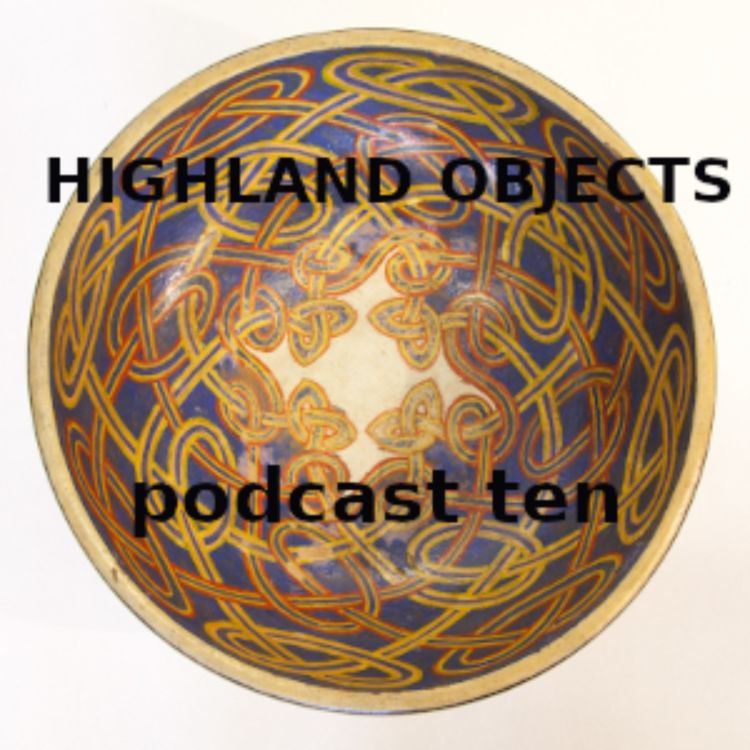Share

Highland Objects Podcasts
George Bain Celtic-Design Bowl
Season 1, Ep. 10
•
A bright, intricate Celtic-design bowl created by a Celtic artist at the home of artist and educator George Bain’s house in Drumnadrochit in the 1940s.
Location: Groam House Museum, High St, Rosemarkie, Fortrose IV10 8UF
More episodes
View all episodes

Bonus Podcast Four
15:45Three Festive Feasts from The Highland Historian, The Highlanders Museum, and Castlehill Heritage Centre.Highland Christmas traditions, a memory of the Christmas Truce in WW1 and a Christmas shipwreck!Festive Fare :o)
Bonus Podcast 3 - Janet Nein Gibbie Gow
06:25The spooky story of Janet Nien Gibbie Gow and the Witch Pricker courtesy of Tain Museum
32. The Ulbster Stone
09:25Carved in the 8th century, this magnificent rock is named after the coastal village of Ulbster, south of Wick, where it was unearthed in 1770 in the graveyard at St. Martin’s Chapel. A few decades after its discovery, the stone was moved to the top of an artificial mound in front of Thurso Castle. There it was during the 19th century that the stone was defaced, with an inscription in Gothic script being carved into its side.The Ulbster Stone is said to bear more symbols on it than any other Pictish monument. Symbols such as the crescent and V-rod, a double-disc, a paired crescent, a step, and a wide variety of animals. Among them a fish, a hippocamp (mythical Sea horse with a fish-tail), a lion, a serpent and the so called Pictish Beast.The most notable symbols however are the two great Latin crosses that dominate both of its two sides, each adorned with lavish, elaborate patterns.As with all Pictish carvings, the true meaning behind the Ulbster stone and its many symbols are unlikely to ever be decisively confirmed. But the great amount of unique symbols provides a wealth of insight into Pictish culture and opens the door to many valuable interpretations.Location: North Coast Visitor Centre, High St, Thurso KW14 8AJ
31. Tarbat Blue Glass Stud
11:03An object from Portmahomack it is a composite blue glass stud inlaid with silver wire and red enamel and was made in the Pictish monastic smiths’ hall of the Pictish monastery at Portmahomack. The size of this blue glass stud belies its importance to Pictish archaeology; it is only about the size of a 5-pence piece, but was crafted by a craftsman working in the smiths’ hall of the Pictish monastery at Portmahomack, Tarbatness in the 8th century. The stud is so like those on the famous treasure, the Derrynaflan paten, that it has been suggested that the same craftsman was at work at Portmahomack. The stud is made of dark blue glass and was inlaid with fine, geometric silver wire, creating cells that were in turn inlaid with red glass or enamel, now decayed to a yellow colour. The stud was broken and this may explain why it was disposed of in a heap of smith’s waste. It was intended to be set into a metal collar fastened to a large complex object, perhaps a chalice, paten or reliquary. The smith who made it was engaged in making some of Europe’s finest metalwork masterpieces, so fine and intricate they are often likened to the ‘work of angels’. This object, and many others from the Pictish monastery at Portmahomack, are on display at the award-winning Tarbat Discovery Centre, Portmahomack.Location: Tarbat Discovery Centre, Tarbatness Road, Portmahomack, Tain, IV20 1YA
30. The Gairloch Pictish Symbol Stone
06:17The Gairloch Pictish Symbol Stone is a great example not only of Pictish carvings showing wildlife but also of the trials and tribulations of many Pictish stones which have had a chequered past between the time of their carving and their current safe homes in museums. It is also a rare example of a west coast Pictish stone and it makes us ask the question – how many more Pictish stones are hidden in the West Highlands, waiting to be found and rescued?This object was runner up in the March 2022 voteLocation: Gairloch Museum, Gairloch, Ross-shire, IV21 2BH
29. Hilton of Cadboll Base Stone
10:10On its discovery on the original site of the Hilton Stone, NMS lobbied/instructed that the base should be transported to Edinburgh to be exhibited alongside the larger section of the Stone already on display.The people of Hilton took exception to this strategy and formed the Historic Hilton Trust who lobbied for the stone to remain in its home village.After a protracted dispute agreement was reached that the Stone could remain in Hilton Village.This reversed the policy that important artefacts automatically go to Edinburgh. The outcome is a change in policy by HES and NMS that important heritage artefacts can stay in their original location to be enjoyed by locals and visitors alike.Location: The Seaboard Centre, East Street, Balintore, IV20 1UA
9. The Gunna Breac
07:53The Gunna Breac was a treasured possession of the MacDonalds of Dalchnosie originally dating to the late 17th/early 18th centuries. It was brought to the Battle of Culloden (1746) by Alexander MacDonald who fought with the Atholl Brigade. A fabulous piece of Jacobite history for all Outlander fans!Location: Museum of the Isles Armdale Castle Armadale Sleat, Isle of Skye IV45 8RS
8. The Hector Model
07:59This 18th Century model of the Hector, which is heralded as ‘Canada’s Mayflower’ may seem innocuous, however the story that it depicts is one of suffering and destitution, yet hope and new beginnings. It holds within it the origins of the people of Nova Scotia, who left Lochbroom in 1773 in search of a new world and new life. Location: Ullapool Museum, 7 & 8 W Argyle St, Ullapool IV26 2TY